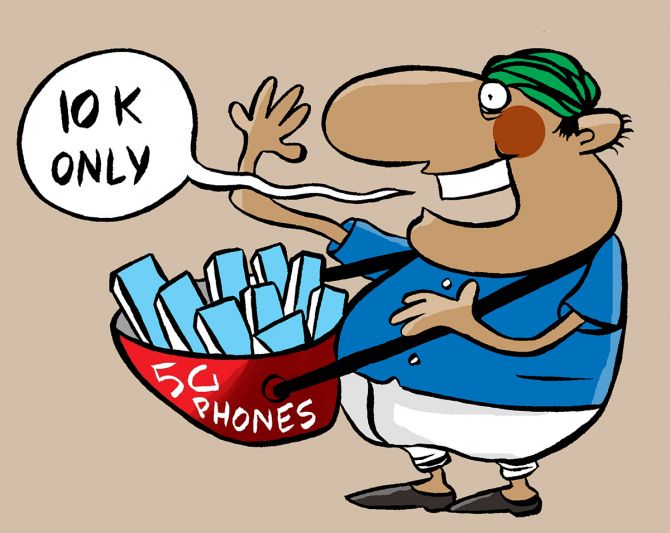5G spectrum auction may turn out to be a short affair

Telcos participating in the upcoming auctions at the end of July say they expect only a fourth of the value of spectrum on offer to be sold.
The government has put Rs 4.3 trillion of spectrum up for sale at the base price across seven bands including for 5G.
An executive of a leading telco said he estimates that mobile operators collectively would buy spectrum of only around Rs 1.1 trillion.
This low share, he said, is because telcos will concentrate in this auction “primarily on buying 5G spectrum” as they want to roll out services by end of this year.
“So they will acquire large quantities in two bands — the 3.5 GHz and millimetre bands.
“And as there is enough spectrum available, we don’t expect competition and the auction price could be the same as base price in most cases.
“Don’t be surprised if the auction is over in a day,” he said.
Of course, telcos are interested in buying the 700 MHz band, where 660 MHz of spectrum is on offer.
It is a key band for 5G.
But most telcos say it is too expensive, especially as they have to make additional investment to utilise the band. For this reason, they say it might remain unsold for the third time even after a substantial lowering of its price.
Telcos might not be off the mark.
The country’s history of auctions since 2012 has been one of unsold spectrum, high prices and a faulty spectrum auction design which has seen a lot of the airwave being sold at the administered base price determined by the government instead of being market determined.
As a result, since 2012, the amount of unsold spectrum in each of the six auctions has ranged from 10-85 per cent.
In four of them, a majority of the spectrum was sold at the base price.
Telecom consultant Mahesh Uppal, who has seen all the auctions, said the design was faulty in that the base price fixed administratively became the market price in most cases.
“Despite claims to the contrary, the government has prioritised revenue maximisation while fixing the base price, rather than keeping it lower and allowing spectrum to expand the market.
“This would have eventually expanded broadband and the government share of revenues,” said Uppal.
He added that the government failed to take the risk, resulting in a large part of the spectrum remaining unsold since 2016.
Many former officials who worked in the Department of Telecommunications admit that, following the alleged scams and investigations, no official was prepared to stick his or her neck out to reduce the price out of fear of allegations of corruptions.
The safest bet was to price it high.
These developments coincide with industry consolidation.
The number of spectrum buyers fell from seven in 2010 to three in 2021.
On the supply side, meanwhile, the government splurged by not only increasing the quantum of spectrum but increasing it in many more bands.
In the 2016 auction, the amount of spectrum came to more than the total spectrum offered in the four previous auctions combined.
This month’s auction will offer a staggering 72 GHz (72,000 MHz) thanks to the sale of a huge amount of spectrum in the millimetre band for 5G.
If the 2014 and 2015 auctions were different, it was because telcos bid aggressively to buy spectrum for launching their pan-India 4G services, especially in the key 1800 band.
As Uppal points out, the incumbents also had to pay a premium to retain their spectrum in bands such as the 900 ban in the key metros because it was going to expire.
Consequently, the government was able to sell 81 per cent and 89 per cent respectively of the total spectrum on offer.
In these two auctions, it was able to generate revenues of over Rs 1.7 trillion.
The only time the entire spectrum was sold was in India’s first auction in 2010 and that was due to the government ensuring scarcity with eight players slugging it out for three blocks of spectrum of only 5MHz.
That year was also the first time that spectrum in the 3G band was being assigned. No telco could afford to be out of the race.
The result was cut-throat competition — the entire spectrum was sold much above the base price.
Telcos paid an average of Rs 110 crore per MHz.
But in 2016, none of the operators bid for the lucrative 700 band because it was priced through the roof.
Globally, the 700 band is seen as a premium band for 5G.
It can offer coverage from a tower of anything between 7-10 kilometres which, combined with a band which offers high speed, can provide high quality 5G services.
The 700 band is also key to the proliferation of broadband across the country.
The 800 and 900 bands do the same but they are currently being used for 2G, 3G and 4G by telcos and the coverage is much lower, between 2.5 km to 3.5 kilometre.
The regulator offered the spectrum at a mind-boggling price of Rs 11,485 per MHz, pricing it at twice the base price of the 1800 ban.
It meant that telcos that required at least 5MHz of spectrum in this band would have had to spend close to Rs 58,000 crore each.
In fact, all they spent jointly was Rs 65,789 crore in the 2016 auction.
But they did not keep away only from 700; there were no buyers for 900 and very few for 800 or the 2100 band.
As a result, 60 per cent of the spectrum remained unsold.
They did the same thing again in 2021 when the same 700 band spectrum was on offer, this time at a hefty discount on the previous base price.
Again, telcos stayed away.
Source: Read Full Article

